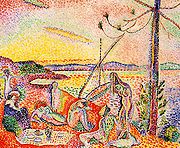
Luxe, Calme et Volupté
Encyclopedia

Oil paint
Oil paint is a type of slow-drying paint that consists of particles of pigment suspended in a drying oil, commonly linseed oil. The viscosity of the paint may be modified by the addition of a solvent such as turpentine or white spirit, and varnish may be added to increase the glossiness of the...
ing by Henri Matisse
Henri Matisse
Henri Matisse was a French artist, known for his use of colour and his fluid and original draughtsmanship. He was a draughtsman, printmaker, and sculptor, but is known primarily as a painter...
. It was painted in 1904, after a summer spent working in St. Tropez on the French Riviera
French Riviera
The Côte d'Azur, pronounced , often known in English as the French Riviera , is the Mediterranean coastline of the southeast corner of France, also including the sovereign state of Monaco...
alongside the neo-Impressionist
Neo-impressionism
Neo-impressionism was coined by French art critic Félix Fénéon in 1886 to describe an art movement founded by Georges Seurat. Seurat’s greatest masterpiece, A Sunday Afternoon on the Island of La Grande Jatte, marked the beginning of this movement when it first made its appearance at an exhibition...
painters Paul Signac
Paul Signac
Paul Signac was a French neo-impressionist painter who, working with Georges Seurat, helped develop the pointillist style.-Biography:Paul Victor Jules Signac was born in Paris on 11 November 1863...
and Henri Edmond Cross. The painting is Matisse's most important work in which he used the Divisionist
Divisionism
Divisionism was the characteristic style in Neo-Impressionist painting defined by the separation of colors into individual dots or patches which interacted optically....
technique advocated by Signac, which Matisse had first adopted after reading Signac's essay, "D'Eugène Delacroix au Néo-impressionisme" in 1898. Signac purchased the work, which was exhibited in 1905 at the Salon des Indépendants. Matisse subsequently abandoned the Divisionist technique.
The painting's title comes from the poem L'Invitation au voyage, from Charles Baudelaire
Charles Baudelaire
Charles Baudelaire was a French poet who produced notable work as an essayist, art critic, and pioneering translator of Edgar Allan Poe. His most famous work, Les Fleurs du mal expresses the changing nature of beauty in modern, industrializing Paris during the nineteenth century...
's volume Les Fleurs du mal
Les Fleurs du mal
Les Fleurs du mal is a volume of French poetry by Charles Baudelaire. First published in 1857 , it was important in the symbolist and modernist movements...
(The Flowers of Evil):
Là, tout n'est qu'ordre et beauté,
Luxe, calme et volupté.
There all is order and beauty,
Luxury, peace, and pleasure.

